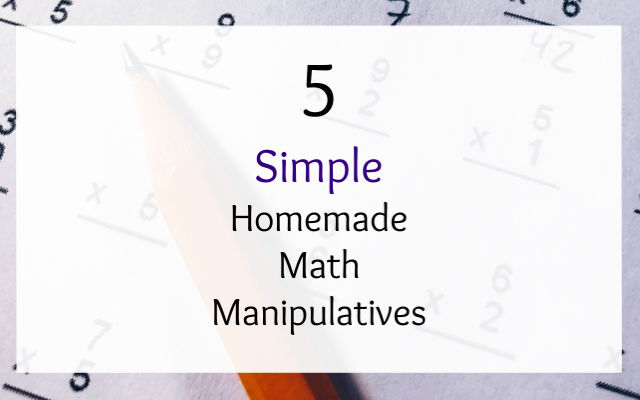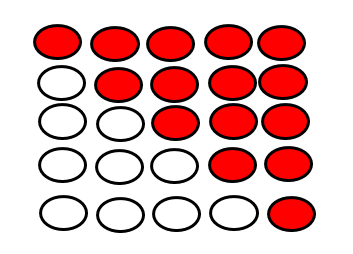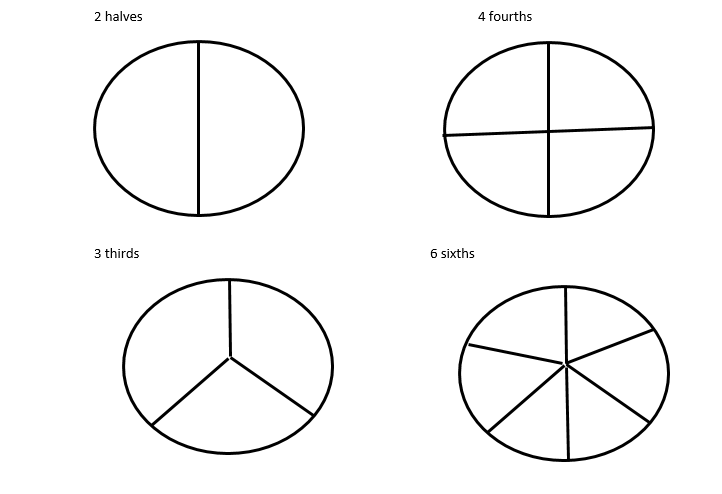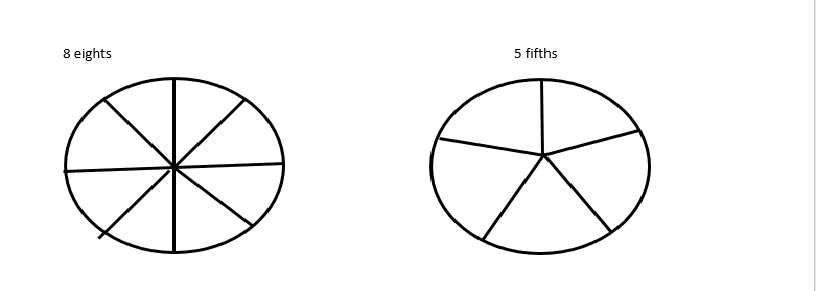5 Simple Homemade Math Manipulatives


Using manipulatives helps students understand math concepts. The visual aspect really helps many students learn the material.
Homemade Math Manipulatives
Because they aid in understanding, manipulatives are an essential part of math instruction. Unfortunately, store bought, ready-made manipulatives may be outside your homeschool budget. To help, here are five manipulatives you can make at home.
They’re all simple to create, and don’t require a ton of fancy supplies. As you read through this post, you’ll find directions for each, along with a few tips on how to use them to support your math instruction.
So gather what you need and have your kids help you prepare them!
1. Double-Sided Counters
To make your own double-sided counters, you’ll need:
- Large lima beans (uncooked)
- Fingernail polish or spray paint
- Newspaper to protect your work surface
You’re going to paint one side of each bean. The fastest way to do this is to line your beans up on newspaper in a single layer. Then give them all a quick coat of spray paint.
Alternatively, you can paint one side of each bean individually with some nail polish. This is a fun way to get the kids involved. However, it takes a lot longer.
No matter which method you use, make sure you give your beans plenty of time to dry. Then store them in a Ziploc bag or an old cookie tin. You don’t want them to get wet.
Use Counters to:
- Demonstrate addition or subtraction problems.
- 1 red counter plus 3 white counters equals how many counters in all?
- If you have ten counters and take away all four white ones, how many are left?
- Bring story problems to life.
- Sally picked three red flowers and five white flowers. How many flowers did she pick in all?
- Make arrays for teaching multiplication (with the same color up).

Three rows of four counters equals 12 total counters. 4 X 3 = 12
- Teach the different ways to make the same number
You can make five with:

1 red and 4 white (1+4=5)
2 red and 3 white (2+3=5)
3 red and 2 white (3+2=5)
4 red and 1 white (4+1=5)
5 red and 0 white (0+5=5)
2. Fraction Plates
Fractions are a hard concept for many learners. Especially when they’re trying to remember if 1/4 is smaller than 1/3. A set of fraction pieces are a great way to help reinforce fractions.
- To make your own, you’ll need:
- 7 paper plates that are all the same size
- A ruler
- A permanent black marker
- Scissors
You’re going to turn each plate into a set of fractions. Use a ruler and marker to make your lines, and then carefully cut them apart. Each piece of each plate must be the same size, to show that fractions are a whole divided equally.
You’ll wind up with:


Leave one plate intact to represent the whole.
Use Fraction Plates to:
- Experiment with equivalent fractions.
- How many eights does it take to make a ½?
- What is the same as two sixths?
- Explore sizes of different fractions.
- What is bigger, a fifth or a third?
- What’s the piece called that is ½ of a ¼?
- Solve basic addition and subtraction problems with fractions.
- If you have ½ and you add ¼, how much do you have?
- What happens when you take a sixth away from a third?
3. Bundles of 10
Place value is the understanding that each digit in a number represents something. The digit in the ones column shows how many ones. The digit in the tens column shows how many tens, and so on.
This concept can seem rather abstract to young learners; so creating bundles of 10 is a great way to provide understanding.
You’ll need:
- 100 straws, coffee stirrers, or toothpicks
- 11 rubber bands
Have your child count out a group of 10 straws and bundle them with a rubber band. Continue until there are 10 groups of 10 items each.
Use Bundles of 10 to:
- Represent numbers 0-99.
- To represent 34, your child would use 3 whole bundles. Then they’d open another bundle and take four of those straws out. Then they’d have three groups of ten (30) and four to make the number 34.
- Practice skip counting by 10s.
- Understand that 100 is 10 groups of 10.
- Use an 11th rubber band that’s slightly bigger to bundle all ten groups of 10 together. Ask your child how many straws are in the big bundle.
4. Geoboard
Geoboards help students visualize geometric concepts. They can make basic shapes, learn about areas and perimeters, and bring geometric vocabulary words like parallel to life.
To make your very own geoboard you’ll need:
- An 8”X8” piece of wood (sanded to avoid splinters)
- 49 nails
- A ruler
- A pencil
- A hammer
- A package of rubber bands
Using your ruler, mark off a grid of 1-inch by 1-inch squares on your board. Then at every intersection, hammer in a nail half-way. You don’t want to pound the nails all the way in, because you need the tops to act as pegs.
You’ll wind up with a one-inch border around your geoboard, and 49 pegs pounded in to hold the bands.
Use Your Geoboard to:
- Explore basic shapes.
- Ask your child to make a triangle.
- Or square.
- Or any other shape.
- Create shapes that are congruent or similar.
- Build parallel and perpendicular line segments.
- Find the area of a square.
- Calculate the perimeter of a rectangle.
- Create complex geometric designs using basic shapes.
5. 10 Frame
A ten frame helps students visualize the numbers 1-10. They encourage students to use the five and ten spaces as visual references, to help build mental math skills. To make one of your own, you’ll need:
- An egg carton
- Scissors
- Counters (your painted lima beans work well!)
Cut the top off your egg carton. Next, cut off the little piece with the tabs that keeps the egg carton closed.
Now you have a section with 12 egg holders. Carefully cut off the last set of two, leaving two rows of five holders each.
This is your ten frame!

Use the Ten Frame to:
- Learn about odd and even numbers.
- Build one-to-one correspondence.
- Practice addition and subtraction facts through 10.
What Homemade Math Manipulatives Do You Use?
If you’ve created your own manipulatives for math before, I’d love to hear about them. Please share in the comments below.
Lisa Tanner is a homeschooling mom of eight. She loves writing about balancing diapers and deadlines, and ways to make learning fun.















































Hi Ma’am
Thanks a lot for wonderful suggestions. Please let me know what outdoor activities to be included for teaching and learning Math for grade 5 students .